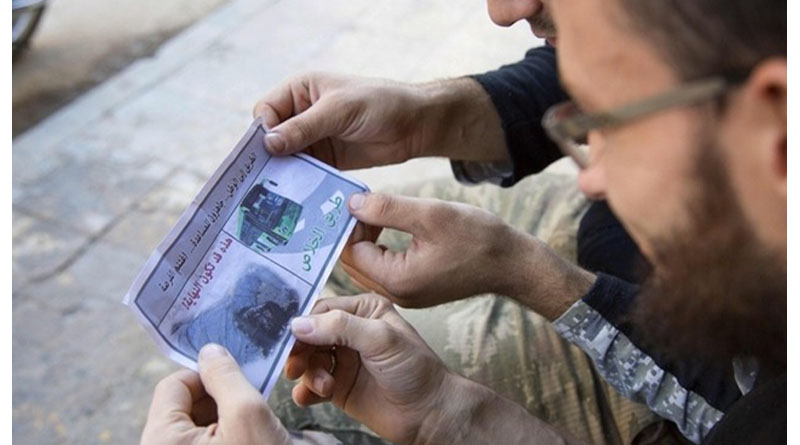How the Russian-Syrian ‘Humanitarian Pause’ in Aleppo was Designed to Fail

Image Caption: Opposition fighters look at a flyer reportedly distributed by the government encouraging people to leave a rebel-held area of Aleppo on October 20, 2016. Karam Al Masri/AFP
BEIRUT // When a three-day “humanitarian pause” in eastern Aleppo expired on Saturday evening, it did not take long for Russia and the Syrian government to resume air strikes on the rebel-held area. With bombs crashing down, food stocks still low and no way to escape, life for civilians in eastern Aleppo quickly returned to normal.
Between Thursday and Saturday, the Syrian government provided routes for rebels and civilians to evacuate to either regime-held territory or to opposition lines outside the city. They guaranteed safe passage – even for fighters, if they left behind their weapons – but hinted at a larger attack to capture the east when the evacuation ended. Although the humanitarian pause was presented as a last chance to escape eastern Aleppo, few if any civilians took up the offer.
The rebels do bear some responsibility for this. They told civilians not to cross because it was too dangerous, and continued to engage in battles with regime forces during the unilateral ceasefire. But now that the pause has ended, it has become clear that Russia and Syria designed it to fail – as a gesture that would allow them to shrug off international criticism while keeping up the full pressure of a siege imposed in September.
The crossing points were lined with masses of armed government soldiers. The buses waiting to transport the evacuees were plastered with pictures of Syrian president Bashar Al Assad. It looked more like a surrender point than an evacuation.
Hungry, under heavy bombardment and, in some cases, increasingly upset with the rebel forces whose war brought them to this point, many of the 275,000 civilians in eastern Aleppo are ready to quit the city.
But even those who are now wary of the rebels have no trust in the regime. The government has ruthlessly and indiscriminately pounded civilian neighbourhoods for years. In recent weeks it has targeted hospitals and emergency workers in eastern Aleppo, ensuring that many of those injured in its attacks will die.
The government pretends civilian deaths do not occur on the rebel side, insisting it is carefully targeting only terrorists, as it describes the rebels. Confronted last week with the photo of five-year-old Omran Daqneesh, bloodied and shell-shocked after an air strike in eastern Aleppo in August, Mr Al Assad said it was “a forged picture and not a real one”.
After all of this, marching up to lines of government soldiers and boarding buses adorned with posters of their chief tormentor remains unthinkable.
The uncertainty and brevity of the Russian-Syrian pause also ensured that no aid got into rebel-held Aleppo, despite urgent warnings from the United Nations that food stocks will run out by November. The truce was initially for only 11 hours until Thursday evening, a window that left the UN and partner aid organisations uneasy about deliveries. And Russia only announced its two 24-hour extensions at the last minute, making planning for deliveries difficult. Moscow and Damascus knew that the UN and aid organisations would not be able to deliver humanitarian supplies if the truce was structured like this. By keeping aid out, Russia and Syria did not skip a beat in their siege, despite the pause’s humanitarian moniker.
The prospect of another break in the fighting or a real evacuation appears distant.
“The question of renewing the humanitarian pause is not relevant now,” Moscow’s deputy foreign minister, Sergei Ryabkov, said on Monday.
Meanwhile, the rebels’ powerful Jaish Al Fatah alliance has said it will launch a new offensive from outside the city to break the siege. With an intensified fight now imminent, it is difficult to imagine that there will be a meaningful pause in the fighting.
On Monday government forces took a strategic hilltop south of Aleppo amid a barrage of air strikes, and pounded the city’s east with tanks and cannon, continuing its campaign for complete control of the city.
For the civilians trapped in eastern Aleppo, the situation is more dire than ever. They won a respite from air strikes during the humanitarian pause and its run-up, but that was all. Their food and medical supplies continued to run down. Their days are still numbered.
* With additional reporting from Agence France-Presse and Associated Press
(Source: TheNational.ae)



